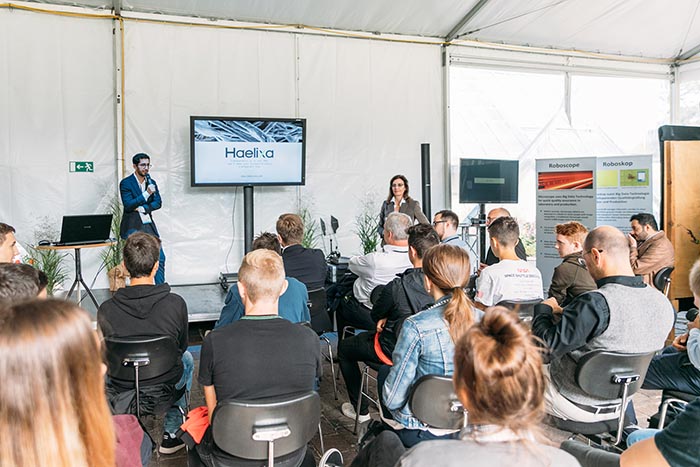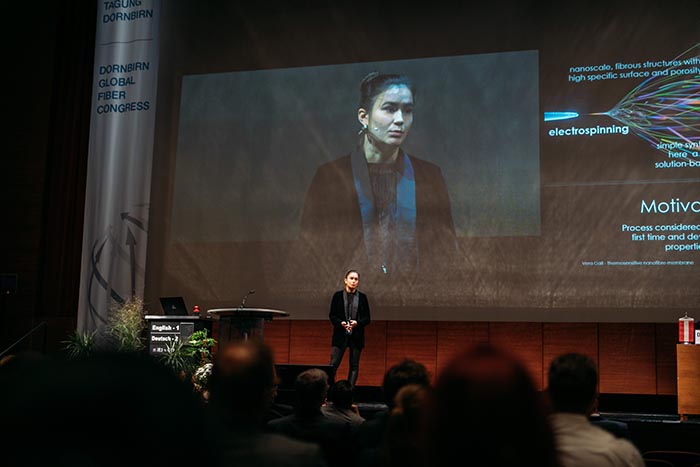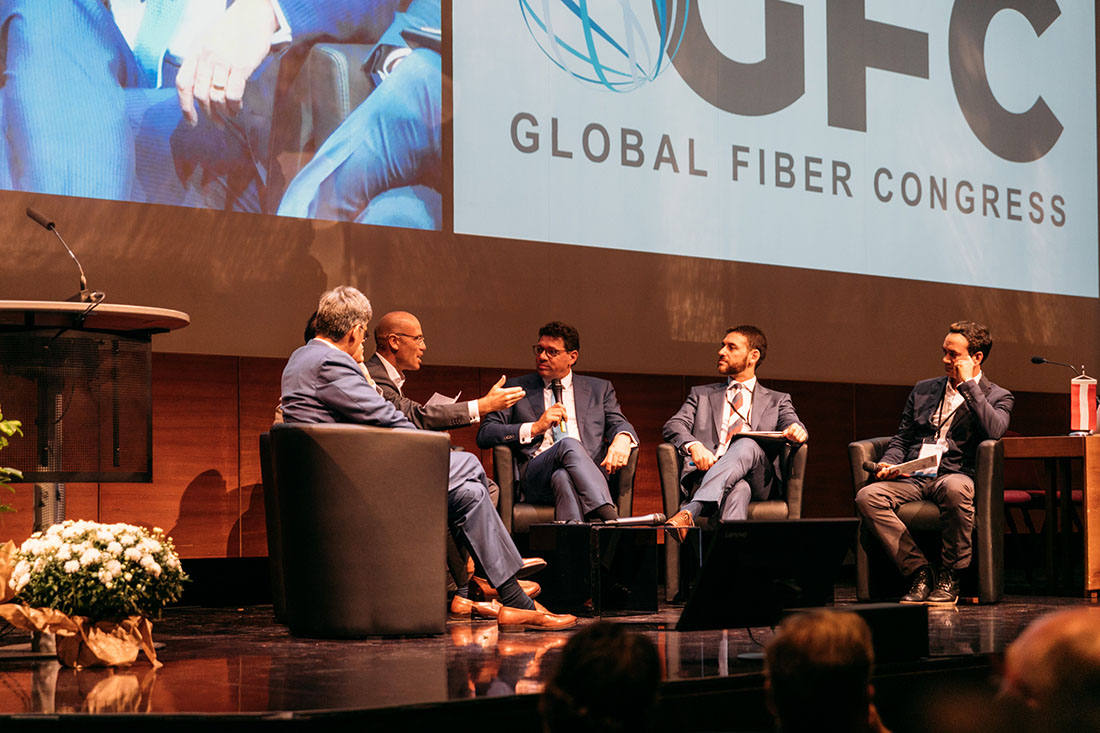Under the backdrop of climate change and environmental pollution, the fiber industry has become a major focal point for the textile and nonwoven industries, as well as along the entire value chain, from sourcing of raw materials through to the manufacture of apparel and technical products.
This year’s Global Fiber Congress held in September in Dornbirn, Austria, continued with this overriding theme, again featuring presentations and discussions on the interlinked issues of sustainability, the circular economy and digitalization.
The 58th congress attracted more than 700 delegates from 32 countries, of which 75% were from Europe, including 37 participants from Turkey. With more than 100 lectures – around half from academic and research institutes – the main topics were: fiber innovations; the circular economy and sustainability; digitalization and smart textiles; surface modification and additives; sports and leisure wear; and nonwovens and technical textiles.
Driving change
While facing a bleak economic outlook in 2019, particularly with the ongoing US-China trade dispute, Frédéric Van Houte, director general of CIRFS, the European Man-made Fibres Association, reminded the conference that the production of man-made fibers continues to grow, with China the world’s main player based on production of 74.7 million tonnes in 2018 and polyester the main fiber with a global output of 55.6 million tonnes.
Global demand for fibers is predicted to increase from 105 million tonnes in 2017 to an estimated 123 million tonnes in 2023, a compound annual growth rate of 3–4%. Synthetic fibers are predicted to grow to 80 million tonnes (+4–5%) and wood-based cellulosic fibers to 9 million tonnes (+4–6%), while cotton and other natural fibers will remain static.
However, Robert van de Kerkhof, president of the Austrian Fibers Institute and chief commercial officer of cellulosic fiber producer Lenzing, questioned whether the global apparel retail market will grow, as some forecasters predict, by 6% a year from US$1.5 trillion in 2019 to US$2.0 trillion in 2024.
“All brands and the industry in general are now setting targets in terms of driving change and seeking sustainable alternatives,” van de Kerkhof told delegates. “But we cannot continue doing what we do, especially in the fiber sector, which is one of the most polluting industries on earth.
“We need to look for much wider sources of innovation to understand the whole picture, including partnerships with governments and NGOs for systemic change, and we must find ways to change our business models.”

Optimizing resource utilization
Uday Gill, chief executive officer of Indorama Ventures’ fibers business, agreed that sustainability is one of the industry’s biggest challenges. “We need to optimize resource utilization to prosper sustainably,” he said.
Gill questioned whether the world’s current consumption behavior is sustainable and whether this needs to be so resource-heavy, especially for consumers in affluent countries.
“Developing countries also have aspirations, so when they get rich, their consumption will increase,” he pointed out. “And there will be more demand for plastic from these emerging nations as they become more affluent.”
Gill explained that humans began exceeding Earth’s sustainable capacity in 1985 – and this trend has continued alongside a hugely profligate lifestyle.
“Nature is paying the price and some 30–50% of species could be extinct by 2050,” he stated. “And we will not escape the consequences of this ecological imbalance, for example, in terms of air quality and fresh water availability.”
But is reducing consumption the solution? The world is generating waste at unmanageable levels, with plastics in particular entering the oceans as unmanaged waste.
“So, should we go back to aluminum paper and glass?” he asked, pointing out that there is a cost in switching back to “conventional” packaging materials, which are resource-heavy and result in high energy intensity and emissions.
Gill noted that bioplastics in themselves will not solve the sustainability challenges as their production is small and they compete with food crops in terms of land area.
He argued that plastics can in fact be a sustainable solution, as they can be recycled endlessly and can replace resource-intensive materials. The solution is how to manage plastics as a resource, not to ban them; optimized resource use is a far better alternative.
Meanwhile, countries such as Japan and Germany are role models for plastics recycling, treating waste as an asset alongside designing products for recycling.
Gill believes that chemical (as opposed to physical) recycling could be the answer, although the problem is how to scale up the technology to deliver quality recycled raw materials.
Indorama is already a major recycler of polyethylene terephthalate (PET) and plans to become the world’s largest reprocessor. The group has just announced a US$1.5 billion investment program for new recycling initiatives, focused mainly on PET resins, and has appointed a chief recycling officer to its board.

CEO panel
During the CEO panel discussion on “Sustainability/circular economy – are we leading or lagging?”, it was observed that of the more than 100 million tonnes of fibers currently produced annually, 75% of all textiles made from them go to landfill or are incinerated, almost all of which could potentially be returned to virgin feedstock or as recycled fibers.
Yogendra Dandapure, innovation director of Canada-headquartered sports apparel retailer Lululemon, believes future consumers will be even more environmentally conscious than today. Indeed, a study has shown that 42% of global consumers want new products that are socially responsible and eco-friendly.
And while Lululemon has, like other major brands, committed to using more recycled PET fiber in the next five to seven years, there will not be enough availability to meet all these goals. “Price can be an issue, so recycled raw materials will have to be price-competitive,” he added.
Gunjan Sharma, chief marketing officer of Reliance Industries’ polyester sector, described the company’s success in PET bottle recycling in India, which has increased by 80% in recent years.
Reliance is now collecting two billion PET bottles a year, which are being recycled into fibers, and the company is creating awareness of sustainability issues, for example, by working with designers and other influencers, and following the lead of Europe in terms of recycling.
Gill agreed there will be a shortfall in the volume of recycled PET. “We cannot just rely on recycling PET bottles,” he said. “The fiber industry will have to look at the chemical recycling of textiles, like for like, segregating the various polymers or oligomers, and not just down-cycling materials into products such as low-value nonwovens or shoddy.”
All the CEO panelists agreed that the brands will have to work with the whole value chain and establish partnerships for change and drive innovation.
However, van de Kerkhof was unconvinced of the sustainability targets of many of the big clothing brands, because they rarely talk with fiber producers and fail to understand the synergies of fibers in blends, as well as the use of dyes and chemicals in terms of potential chemical recycling.
Clearly, the Dornbirn congress as a whole needs more participation from the downstream brands – and it has yet to fully embrace natural fibers, alongside cellulosic and other man-made fibers, which have always been the core of this annual networking event.
Young researchers
During the opening session of the congress, the Paul Schlack/Wilhelm Albrecht Prize 2019 was awarded to Vera Gail of the University of Applied Sciences, Hochschule Niederrhein, Germany, for her work on thermosensitive nano-membranes.
The congress also featured an expert panel discussion on digitalization, as well as the fourth Young Scientist Forum, in which 15 young researchers discussed current challenges under the leadership of Syngroup Consulting.

Startup days
The Dornbirn-GFC Startup Days took place for the first time this year in cooperation with PricewaterhouseCoopers (PwC), where around 25 selected startup companies had the opportunity of presenting their innovations to congress delegates.
An international expert jury selected the three best projects, which received prize money from Lenzing, and consulting services and further support from PwC.
The winners were London, UK-based Ananas Anam for its Piñatex material made from pineapple leaf fiber; re:newcell of Stockholm, Sweden, for its process for chemical recycling of cellulosic textiles into high-quality dissolving pulp; and Israeli startup Sonovia for a single-step coating technology that eliminates the need for chemical binders.

Next congress
The 59th Dornbirn Global Fiber Congress is planned to be held on September 16–18, 2020 with the main topics: fiber innovations; circular economy and sustainability; surface modification and additives; mobility, apparel, nonwovens and technical textiles.
Companies and organizations interested in making a presentation should email the Austrian Fibers Institute with proposals, including the working title and abstract, by December 31, 2019.
For more information contact:
Austrian Fibers Institute
Tel: +43 1 319 290941
Fax: +43 1 319 290931
office@dornbirn-gfc.com
www.dornbirn-gfc.com


